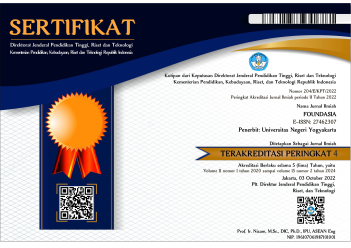High order thinking skill sebagai landasan dalam pengembangan asesmen dan evaluasi pendidikan
Abstract
Studi ini memberikan wawasan tentang konsep keterampilan berpikir tingkat tinggi sebagai kompetensi yang integral dengan keterampilan berpikir tingkat rendah. Kompetensi berpikir kritis dan kreatif sebagai kompetensi tingkat tinggi terbentuk dari kompetensi berpikir tingkat rendah dari kemampuan mengingat, memahami, menerapkan, menganalitis, hingga mampu berpikit kritis dan kreatif. Pengetahuan sebagai obyek berpikir memiliki dimensi-dimensi dari pengetahuan faktual, konseptual, prosedural dan pengetahuan metakognitif. Pendidik dalam proses pembelajaran membantu peserta didik berproses untuk mencapai kompetensi yang tinggi melalui pembelajaran yang multi dimensi tersebut dan melakukan penilaian untuk membantu proses pelaksanaan kompetensi serta memastikan ketercapaian evaluasi hasil belajar. Taksonomi pendidikan yang ditemukan oleh Bloom merupakan konsep dasar yang selalu menjadi rujukan dalam menyusun tujuan atau kompetensi pendidikan dan evaluasinya. Kompetensi berpikir kreatif sebagai kompetensi berpikir tinggi yang ditambahkan oleh Andersen di tahun 2001. Pembaruan taksonomi Bloom yang dilakukan oleh Andersen menjadikan konsep ini relevan dengan konteks dunia di abad 21.
Kata kunci: Berfikir tingkat tinggi, asesmen, evaluasi pembelajaran.
Full Text:
59-74 PDFReferences
Abubakar, A., & Attahir, I. S. (2018). Innovative and Creative Skills for the 21st Century Librarian: Benefits and Challenges in Nigerian Academic Libraries. 113–120.
Anderson, L. W., & R. Krathwohl, D. (2001). A Taxonomy for Learning. Teaching and Assessing. Addison Wesley Longman, Inc. All.
Baehr, M. (2007). Distinctions Between Assessment and Evaluation. In Faculty Guidebook Faculty Development Series Section (pp. 441–444).
Bailin, S. (1987). Critical and Creative Thinking. University of Manitoba.
Bloom, B. S., Engelhart, M. D., Furst, E. J., Hill, W. H., & Krathwohl, D. R. (1956). Taxomony of Educational Objective. In A Committee of College abd University Examiner. Longmans, Green and Co LTD.
Center, P. P. R., & Introduction. (2010). 21st Century Skills for Students and Teachers. Kamehameha Schools Research & Evaluation, 1–25. www.21stcenturyskills.com
Dick, W., Carey, L., & Carey, J. O. (2005). The systematic design of instruction. Harper Collin.
Earl, L. M. (1998). Assessment For Learning; Assessment As Learning: Changing Practices Means Changing Beliefs. Assessment and Learning, 2, 1–5.
Earl, L. M. (2003). Assessment as Learning: Using Classroom Assessment to Maximise Student Learning. Thousand Oaks, CA, Corwin Press.
Ennis, R. H. (1987). A taxonomy of critical thinking dispositions and abilities. WH Freeman/Times Books/Henry Holt & Co.
Herwin, H. (2019). Evaluasi Program Pembelajaran IPS di Sekolah Dasar Negeri 126 Lagoe. DIDAKTIKA: Jurnal Pendidikan Sekolah Dasar, 2(2), 41-48.
Hoque, E. M. (2016). Three Domains of Learning: Cognitive, Affective and Psychomotor. The Journal of EFL Education and Research (JEFLER), 2(2), 2520–5897.
Kaçan, S. D., & Şahin, F. (2018). The Impact of Scientific Creative Thinking Skills on Scientific Process Skills. 01060, 1–8.
Krathwohl, D. R. (2002). A revision of bloom’s taxonomy: An overview. Theory into Practice, 41(4), 212–218. https://doi.org/10.1207/s15430421tip4104_2
Krathwohl, D. R., Bloom, B. S., & Masia, B. B. (1964). Taxonomy of educational objectives: The classification of educational goals - Handbook II: Affective Domain. Studies in Philosophy and Education, 169.
Lewis, A., & Smith, D. (1993). Defining Higher Order Thinking. Theory Into Practice, 32(3), 131–137. https://doi.org/10.1080/00405849309543588
Lewis, Beth. (2020, August 28). Using Bloom's Taxonomy for Effective Learning. Retrieved from https://www.thoughtco.com/blooms-taxonomy-the-incredible-teaching-tool-2081869
Locke, E. A. ., & Latham, G. P. . (1991). A Theory of Goal Setting and Task Performance. The Academy of Management Review, 16(2), 480–483.
Mager, R. F. (1962). Preparing instructional objectives. Pearon Press.
O’Neill, G., & Murphy, F. (2010). Guide to taxonomies of learning. UCD Teaching and Learning/Resources.
Pintrich, P. R. (2002). The role of metacognitive knowledge in learning, teaching, and assessing. Theory into Practice, 41(4), 219–225.
Pujiastuti, P., Herwin, H., & Firdaus, F. M. (2021). Thematic learning during the pandemic: CIPP evaluation study. Cypriot Journal of Educational Sciences, 16(6), 2970-3980.
Robert J. Kibler, Donald J. Cegala, Larry L. Barker, & David T. Miles. (1974). Objectives for Instruction and Evaluation. In Educational and Psychological Measurement, 34(3). SAGE Publications Inc. https://doi.org/10.1177/001316447403400335
Saptono, B., Herwin, H., & Firmansyah, F. (2021). Web-based evaluation for teacher professional program: Design and development studies. World Journal on Educational Technology: Current Issues, 13(4), 672-683.
Watson, S. (2019). Higher-order thinking skills (HOTS) in education.
Western and Northern Canadian Protocol (WNCP). (2006). Rethinking Classroom Assessment with Purpose in Mind: Assessment for Learning, Assessment as Learning, Assessment of Learning.
Wilson, L. O. (2016). Anderson and Krathwohl Bloom’s Taxonomy Revised Understanding the New Version of Bloom’s Taxonomy. The Second Principle, 1–8.
DOI: https://doi.org/10.21831/foundasia.v12i2.47332
Refbacks
- There are currently no refbacks.

This work is licensed under a Creative Commons Attribution-ShareAlike 4.0 International License.










